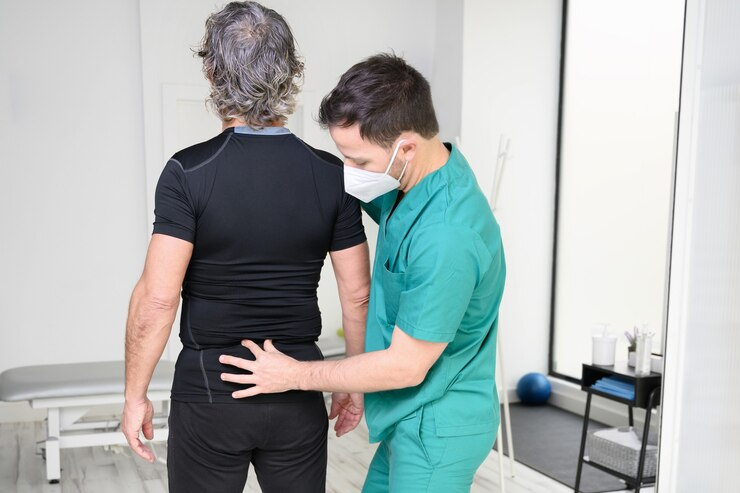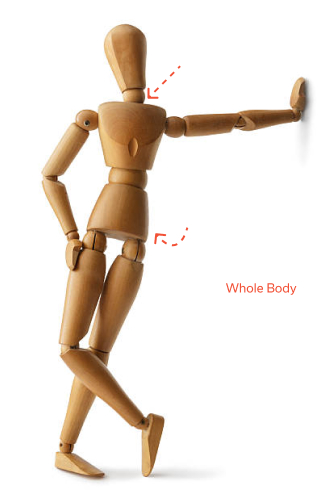Physiotherapy For Osteoarthritis Of The Hip - Definitive Guide
By Estelle GohPersistent hip pain can restrain mobility, strength, and balance, especially among older adults. The discomfort and stiffness significantly impact daily activities and even sleep at night. If you are experiencing joint pain in the hip area without known cause, you could be battling with hip osteoarthritis.
Hip OA is relatively rare in Asian countries, including Singapore. With the country's "ten-year pattern" of hip diseases, only less than 5% of Singaporean adults had advanced osteoarthritis without a determined cause. However, this phenomenon remains an "economic and societal burden."

Joint impairments like hip and knee osteoarthritis currently have no cure that restores the worn-out cartilage. Fortunately, there are effective treatments that manage pain, improve function, and slow the progression of osteoarthritis, including physical therapy.
Physiotherapy for osteoarthritis of the hip helps manage symptoms of this condition in many conservative ways. In this guide, we will discuss how physiotherapy helps with hip osteoarthritis and what exercises are best to improve hip range and mobility.
First, let's understand the risk factors, symptoms, diagnosis, and background of hip osteoarthritis.
What Is Hip Osteoarthritis?
Hip osteoarthritis is a degenerative joint disease that hinders physical function and structure. It is the most common form of arthritis that affects the hip.
Over time, the cartilage cushioning your hip joint wears down, causing bone-on-bone friction. It also affects ligaments and muscles around the hip joints, resulting in pain, stiffness, and reduced range of motion.
The chances of developing hip osteoarthritis increase as you age. Aging declines the body's ability to repair and regenerate tissues. This means the body is less efficient at repairing minor damage to the cartilage in the hip joint, which can contribute to the development of osteoarthritis.
Simply put, the more you use your hips throughout life, the greater the chance of eventual wear and tear. Over a lifetime, activities like walking, running, and even just daily movement can gradually take a toll on the hip joint, especially if there are repetitive motions involved.
How Does It Feel?
The most common symptom of hip osteoarthritis is pain in the hip or groin. The pain may be worse with activity and may improve with rest. Other symptoms of hip osteoarthritis can include:
- Stiffness in the hip, especially in the morning
- Difficulty walking, bending, or putting on shoes
- A grating sensation in the hip
- Reduced range of motion in the hip
Moreover, you might experience pain with activities like climbing stairs or getting up from a chair. Clicking or grinding sounds in your hip joint are also common.
How Is It Diagnosed?
A physical therapist or doctor will typically diagnose hip osteoarthritis based on your symptoms, medical history, and a physical exam that assesses your hip range of motion, strength, and tenderness. Imaging tests like X-rays are sometimes used to rule out other causes of hip pain but aren't always necessary for diagnosis.

It is important to note that the exact cause of hip osteoarthritis is unknown. In your consultation with a healthcare provider, several factors that increase your risk of developing the condition may come up, including the following:
- Obesity: Excess weight puts extra stress on the hip joint.
- Previous hip injury or hip dysplasia: A fracture, dislocation, or other injury to the hip can increase your risk of developing osteoarthritis.
- Family history: Having a family history of osteoarthritis increases your risk.
- Certain occupations: Jobs that require repetitive hip movements or heavy lifting can increase your risk.
How Can a Physical Therapist Help?
Physical therapists are often the first point of contact for people experiencing hip or joint pain. They perform a comprehensive evaluation to diagnose the issue and determine if it is osteoarthritis or another condition.
Trusted physical therapy providers in Singapore like Phoenix Rehab design and implement a personalized treatment plan to reduce hip pain and improve mobility and function. They also provide physiotherapy for a hip labral tear, a repetitive trauma to the hip joint. This early intervention can significantly improve a patient's quality of life and prevent further complications.
Here are some methods physical therapy specialists use to ease hip pain caused by osteoarthritis.
Exercise Therapy
A cornerstone of physiotherapy for hip osteoarthritis is therapeutic exercise. Randomized controlled trials have consistently shown that exercise programs can be as effective as medication in reducing pain and improving function.
Your physical therapist will design a safe and effective exercise program focusing on the following:
- Strengthening exercises: Building strong hip and leg muscles improves joint stability and reduces pain. Exercises might involve using body weight, resistance bands, or weights.
- Range-of-motion (ROM) exercises: Gentle stretches and movements help maintain flexibility and improve your hip range of motion.
- Balance exercises: Strengthening your core and improving balance can help prevent falls, a concern for people with hip OA.
Manual Therapy
Techniques like massage and joint mobilizations can help ease hip pain and stiffness, improving joint function.
Massage therapy improves blood circulation to the affected joint. Increased blood flow brings nutrients to the area and can help remove waste products that contribute to inflammation. Moreover, massages relax tight muscles around the joint that may be causing the stiffness.
Meanwhile, joint mobilizations help stretch the capsule and ligaments surrounding the joint, increasing its range of motion. It may also help break down scar tissue and adhesions contributing to hip pain. Scar tissue and adhesions can restrict movement, and mobilizations can loosen these tissues for restored physical function.
Patient Post-Treatment Education
Your physical therapist will educate you about hip osteoarthritis, proper body mechanics, and pain management strategies. They will also recommend lifestyle modifications to help manage your symptoms, such as maintaining a healthy body weight and using assistive devices like canes.
The American Physical Therapy Association (APTA) recognizes physical therapy as a valuable treatment for hip osteoarthritis. Their clinical practice guidelines recommend exercise and manual therapy as core components of managing hip osteoarthritis.
Can This Injury or Condition Be Prevented?
While not entirely preventable, there are ways and efforts to prevent developing osteoarthritis of the hip. Maintaining a healthy weight, engaging in regular physical activity, and maintaining good posture are just a few strategies.
For strength training exercises, focus on major muscle groups around the hips and legs. Moreover, high-impact activities like running or jumping can put a strain on your hips, so consider replacing them with lower-impact exercises. A physical therapist can help you develop a safe and effective exercise routine with proper form.
Hip injuries can increase your risk of developing osteoarthritis later in life. Taking steps to prevent falls and injuries, such as wearing proper footwear and maintaining good balance, can help protect your hips.
Finally, take into account proper diet and nutrition. While no specific diet can prevent osteoarthritis, some research suggests that a healthy diet rich in fruits, vegetables, and whole grains may help reduce inflammation and contribute to overall joint health.
What Kind of Physical Therapist Do I Need? (Physiotherapy Management)
Any licensed physical therapist can treat hip osteoarthritis. However, some therapists specialize in treating osteoarthritis and other rheumatic diseases. You can ask your doctor for a referral or search for a physical therapist with experience in managing hip osteoarthritis.
The Osteoarthritis Research Society International (OARSI) recommends seeking a physical therapist familiar with the latest treatment approaches for hip osteoarthritis.
Exercises for Osteoarthritis of the Hip
In addition to low-impact activities like swimming, walking, biking, and yoga, several specific exercises can be helpful for managing hip osteoarthritis. These exercises target flexibility, strength, and range of motion in the hip joint, all of which contribute to reducing pain and improving function.
Short Arc Hip Stretches
A great way to begin your exercise routine is with gentle stretches that target the muscles around the hip joint. Here's how to perform short arc hip stretches:
- Lie comfortably on your back with both knees bent and feet flat on the floor.
- Slowly bring one knee towards your chest, hugging it gently for a stretch. Hold for 15-30 seconds to feel a stretch in the front of your hip.
- Lower the leg back down slowly and repeat the stretch with the other leg. Aim for 2-3 sets of 10-12 repetitions on each side.
Hip Abduction Exercises
Strengthening the muscles that move your leg away from your body (hip abduction) improves hip stability and can help reduce pain. Here's how to perform hip abduction exercises:
- Stand with your feet shoulder-width apart (hold a chair or wall for balance if needed).
- Keeping your back straight and core engaged, slowly lift one leg out to the side as high as comfortably possible. Imagine lifting your leg away from your midline, not forward or backward.
- Hold this position for a few seconds, then slowly lower your leg back down.
- Repeat this exercise 10-12 times on each leg. Aim for 2-3 sets of repetitions.
Hip Flexion Exercises
Hip flexion exercises improve your ability to bend at the hip joint. Here's how to perform them:
- Stand with your feet shoulder-width apart.
- Slowly bring one knee towards your chest as high as comfortably possible, keeping your back straight and core engaged.
- Hold this position for a few seconds, feeling the stretch in the back of your hip.
- Slowly lower your leg back down and repeat with the other leg. Aim for 2-3 sets of 10-12 repetitions on each leg.
Tai Chi Classes
Tai Chi is a mind-body exercise that incorporates gentle movements that improve balance, flexibility, and range of motion. These improvements can significantly benefit people with hip osteoarthritis by promoting better coordination and reducing the risk of falls. Consider enrolling in a Tai Chi class or following video instructions online to learn proper form and technique.
Always listen to your body and avoid any exercise that causes pain. If you have any concerns or limitations due to your hip osteoarthritis, consult a physical therapist. They can design a safe and effective exercise program tailored to your specific needs and condition.
Summary
Hip osteoarthritis can be a burden that hinders quality of life, physically and mentally. Physical therapists ensure you are not only getting treatment but also understanding your condition. They also provide self-management techniques to promote some independence in your healing journey.
With the right methodologies and patient education in your treatment plan, a physical therapist can help you reduce hip pain, improve joint function, and maintain an active lifestyle.
Check the Arthritis Foundation for a wealth of information on various aspects of arthritis, including osteoarthritis of the hip. Their section includes information on exercise programs you can use as additional reference.
Browse other articles by category
Physiotherapy for Knee Pain Physiotherapy For Slipped Disc Physiotherapy for Neck Pain PHYSIOTHERAPY
PHYSIOTHERAPY
 Hand Therapy
Hand Therapy
 Alternative
Alternative
 Massage
Massage
 Traditional Chinese Medicine Treatment
Traditional Chinese Medicine Treatment
 Rehab
Rehab
 Physiotherapy For Lower Back Pain
Physiotherapy For Shoulder Pain
Orthopedic Doctors, Insurance & Healthcare
Physiotherapy For Upper Back Pain
Frozen Shoulder
Physiotherapy for Back Pain
Physiotherapy For Lower Back Pain
Physiotherapy For Shoulder Pain
Orthopedic Doctors, Insurance & Healthcare
Physiotherapy For Upper Back Pain
Frozen Shoulder
Physiotherapy for Back Pain

 Whatsapp us now
Whatsapp us now